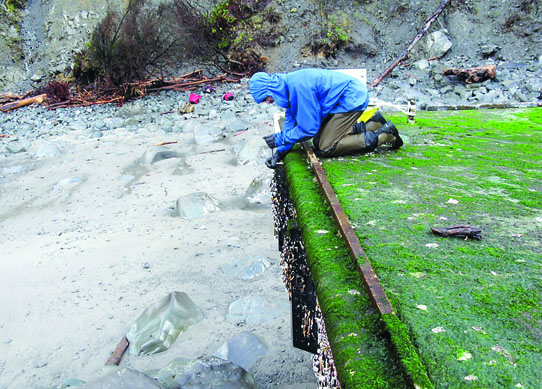LAPUSH — Scientists say they have found no biological invaders on samples of 30 species of marine life taken from a dock that washed up on a remote beach south of LaPush.
The 64-foot concrete and steel dock, which is believed to be debris from the March 2011 Japanese earthquake and tsunami, was spotted by fishing crews Dec. 14 off the coast of Washington state and located Dec. 18 by a Coast Guard helicopter crew on an Olympic National Park beach about 15 miles southwest of Forks.
A temporary command post set up in Forks was closed last weekend and will remain shut down for the time being, said Larry Altose, spokesman for the Washington State Marine Debris Task Force.
Researchers at Williams College in Williamstown, Mass., as well as from the Los Angeles County Museum of Natural History were analyzing samples that were taken last Friday to determine the presence of any invasive marine species.
The state Department of Health is testing samples for possible radioactivity, Altose said.
There has been some concern about radioactive debris because of the meltdown at the Fukushima Daiichi nuclear power plant, which released radioactive water in the weeks following the tsunami.
“We expect radioactivity to be low, like other debris that has been tested,” he said.
A statement issued Thursday afternoon by the state Marine Debris Task Force said the dock has no identfying plaques or other evidence like a plaque found on a dock that washed ashore in Oregon earlier this year.
As a result, officials are not officially confirming the dock south of LaPush as a remnant from the Japanese quake and tsunami.
An eight-person team from the park, state Department of Fish and Wildlife and Oregon State University hiked to the beach last Friday, inspected the dock and took live samples of marine species for laboratory analysis.
They also attached a tracking beacon to the dock in case it is pulled back to sea by high tides.
That tracking beacon has not shown any movement since it was placed, Altose said.
Although officials still aren’t officially declaring the flotsam as tsunami debris, Japanese writing was located in one of the dock’s holds, and photos of the dock have been sent to the Japanese consulate in Seattle for identification.
The beach, which is between LaPush and Hoh River, requires about a 5-mile hike from the nearest road on primitive trails that cross unbridged waterways, is also at the bottom of a steep bluff.
Park trails between Goodman Creek and Jefferson Cove, a stretch of coastline with 200-foot high bluffs where the dock is beached, are now closed to public hiking.
On the Oregon debris, a plaque identified that dock as one of four fish-loading docks owned by Aomori prefecture that were ripped away from the port of Misawa by the 2011 tsunami.
Another of the four docks was located in 2011 on an island south of Misawa.
Before the dock on the Oregon coast was sterilized and destroyed, volunteers found four species native to Japan — a seaweed, a sea star, a mussel and a shore crab — that are known as invasive species elsewhere, according to the Oregon Department of Fish and Wildlife.
Officials there do not yet know if any of the species has taken hold on Oregon beaches.
The Japanese government estimated that the March 11, 2011, tsunami swept about 5 million tons of debris into the Pacific. Most of that sank immediately, while 1.5 million tons were dispersed across the North Pacific.
Anyone sighting other significant debris that may be from the tsunami is asked to report it to DisasterDebris@noaa.gov.
There are two government websites with information on tsunami debris — http://marinedebris.noaa.gov/tsunamidebris and http://marinedebris.wa.gov.
—————-
Reporter Arwyn Rice can be reached at 360-452-2345, ext. 5070, or at arwyn.rice@peninsuladailynews.com.

